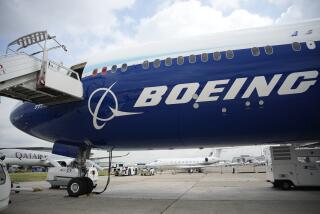Boeing Plans to Merge Space, Defense Units
- Share via
Boeing Co. said Wednesday that it is merging its Seal Beach-based space and communications unit with its military aircraft and missile systems business headquartered in St. Louis, in a move that would allow the company to pursue a bigger chunk of the growing defense budget.
Boeing said it would combine the two units into a $23-billion business under a major realignment that would place all of its defense-related work under one roof. The combined unit, Integrated Defense Systems, would be headquartered in St. Louis and led by James F. Albaugh, president and chief executive of the space and communications unit.
Because the changes are mainly administrative, no jobs or facilities are affected, Boeing executives said. Albaugh and a few of his support staff in Seal Beach will move to St. Louis, but no other personnel changes are expected. Boeing is the largest private employer in Southern California, with about 35,000 employees.
Boeing executives said the “strategic realignment” was mainly designed to improve the company’s ability to go after so-called system-of-systems work, which involves oversight of complex and lucrative integration tasks on multibillion-dollar defense contracts.
The reorganization continues Boeing’s quest to rely less on its commercial aircraft-making business, which has been hammered by the slowdown in air travel after the Sept. 11 terrorist attacks. In less than six years, the company has moved from generating about 85% of its revenue from commercial aircraft to about 60%. Within the next few years, defense and other work may surpass it, analysts said.
The new integrated defense systems subsidiary will employ 78,600 workers, more than the company’s flagship commercial jet unit, which is firing about 30,000 workers and slashing production amid the steep airline slump.
“In simple terms, we are aligning our business today with the way we believe future systems are going to be designed, acquired and maintained,” Boeing Chairman and Chief Executive Philip M. Condit said. For instance, Albaugh will head a management team that will be aligned not by product or program but by customers. Albaugh will manage separate general managers for programs for the Army, the Air Force and the Navy, as well as for missile defense and NASA’s human space flight.
Analysts said Boeing’s move reflects a trend within the defense industry, which has been called on by the Pentagon in recent years to take a greater role in overseeing development of major programs.
In March, Boeing won a major Army contract, potentially worth $10 billion, to develop a network of new weapons, communication systems and intelligence-gathering sensors. It marked the first time that the Army had asked a single defense contractor to oversee development of a range of technologies and weapons.
“They see that as a real growth area,” said Paul H. Nisbet, a defense analyst with JSA Research Inc. “They can do the system integration work more effectively if they have them combined, rather than having to work across major divisions.”
The trend has fueled many high-profile consolidations in recent years, including Northrop Grumman Corp.’s proposed acquisition of TRW Inc.
For Boeing, combining the units would bring together a vast but disparate empire that provides weapons and systems to the Pentagon, including fighter jets, battlefield computer systems, satellites and missiles.
Albaugh said the realignment should benefit operations in Southern California, where the space and communication unit employs nearly 22,000 people, many of them engineers for the design and development of the complex systems that Boeing would go after.
On the New York Stock Exchange, Boeing shares fell $2.42 to $40.80.
More to Read
Inside the business of entertainment
The Wide Shot brings you news, analysis and insights on everything from streaming wars to production — and what it all means for the future.
You may occasionally receive promotional content from the Los Angeles Times.










